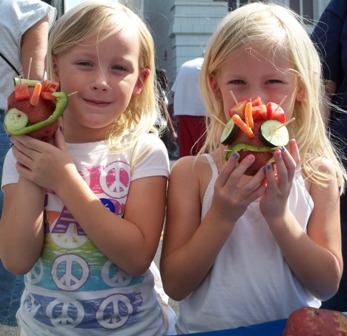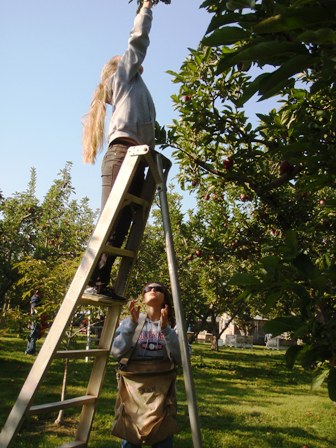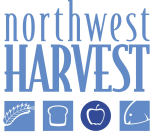A Pick-A-Thon is an event which allows for two organizations to benefit mutually. A produce recovery organization benefits from a gleaning event for a day or multiple days, while the other organization has an event in which they can raise money. Northwest Harvest Yakima and the La Salle High School have hosted a Pick-A-Thon every year for the past 5 years. La Salle raises money for their scholarship fund while simultaneously harvesting produce to alleviate hunger in their community. Pick-a-Thon in Yakima garnered 37,320 lbs and 33,400 lbs of apples and pears in 2011 and 2012, respectively.
Preparation For Large Gleaning Events
Meet with the co-organizers a few weeks or months before the event to touch base. During this meeting, figure out which organizations are responsible for what and discuss details such as bathrooms, information for the students and chaperones (if partnering with a school), where the farms are located, and lunch.
 Responsibilities for Pick-a-Thon in Yakima:
Responsibilities for Pick-a-Thon in Yakima:
-
For Pick-a-Thon, LaSalle High School provides:
-
Lunch for volunteers
-
Transportation to and from the farm
-
Water jugs
-
Opening and closing prayers
Northwest Harvest is responsible for:
-
Picking equipment (bins, bags, buckets, ladders)
-
Water jugs
-
First aid kit
-
Port-a-Potty and handwashing station (1 station/day)
The host farm is responsible for:
-
A walk-through on the morning of or before the event to review safety information, what can be picked, etc.
-
Forklift services – initial bin placement in the orchard and movement to follow pickers, bin placement onto NWH truck gate.
For an all day gleaning event, having a portable toilet is a must, especially for 40-50 volunteers. Having one or two separate hand washing stations is also helpful during the lunch rush to wash hands. Ask a local service club or a donor with ties to the volunteer organization if they would be willing to sponsor the toilet. If the event will be in the same orchard for several days, the toilet can remain, saving time and money. For 40-50 volunteers, estimate using all the water in one hand washing station per day; toilets can handle 2-3 days of use with that number of volunteers.
Be sure students receive a copy of your organization’s gleaning guidelines before the event and that chaperones receive a similar copy which also covers supervisor tips. Be sure to find a final date when you absolutely need to know where the students are going, so that permission slips can be signed. Students can pack their own lunch or a local cafe or nearby fast food restaurant might be willing to sponsor lunch.
Ideally, farms will host Pick-a-Thon for multiple years, so try to approach farms which have ties to your partner organization. Also, retired growers or hobby growers who enjoy maintaining trees but do not sell commercially are great partners for Pick-a-Thon because they have a fairly steady stream of produce, which makes it easier to pair class sizes with orchard sites. Also, a Pick-a-Thon is mutually-beneficial for retired or hobby growers, since it allows their fruit to be picked with little effort on their part.
Alternatives
Be sure to have an alternative productive activity for the group in case of last-minute changes or inclement weather. During Pick-a-Thon, one class of students usually volunteers at the warehouse re-packing the fruit that the other classes picked. Such an activity is still an opportunity for students to get physically active and have a rewarding experience. Think creatively about your own organization or network and brainstorm similar projects.
Logistics
Be certain to ask the producer where to park vans or buses. Do not be afraid to flag the bus down and direct them to exactly where they should be parked. Also make sure that you train students every day, because it will most likely be a new batch of students or even a different type of produce. Most students have never gleaned or worked in an orchard so be sure to explain to them about picking bags, ladders, picking etiquette and where the fruit goes.
Here’s the schedule for a typical day for the gleaning coordinator during Pick-a-Thon:
7:00am – arrive at the warehouse, fill H2O jug, pick up necessary supplies
7:30am – leave the warehouse, head out to the farm
8:00am – arrive at the farm, begin setting up, assess orchard and set up bins with grower
8:30am – LaSalle students leave campus, head to the farm
8:45 to 9:00am – LaSalle students arrive on-farm
9:00am to 9:15am – LaSalle prayer, orientation, farm etiquette
9:15 to 10:30am – Picking
10:30 to 10:40am – Ten minute water and snack break
10:40am to 12:00pm – Picking
12:00 to 12:45pm – Lunch break. Lunch is McDonald’s and is delivered by LaSalle staff.
12:45 – 1:45pm – Picking and orchard clean up.
1:45 to 1:50pm – Final LaSalle prayer
Managing your volunteer force effectively is key to having a smooth and successful Pick-a-Thon, especially if you have a large army of volunteers. For a school with several grades, try to pick at a different farm each day or divide the farm before the volunteers arrive, clearly marking where picking should stop for the day. This will ensure that you have produce to harvest the following day.
Considerations when planning volunteer movement:
-
 Number of chaperones: Ideally, assign chaperones to different sections of the orchard and have them walk around and monitor the students to give reminders and suggestions, keep track of how fast bins are filling up and where full bins are, and monitor the pace of work. Students also tend to miss fruit, so chaperones can call aside students to go back along the row and do quality control.
Number of chaperones: Ideally, assign chaperones to different sections of the orchard and have them walk around and monitor the students to give reminders and suggestions, keep track of how fast bins are filling up and where full bins are, and monitor the pace of work. Students also tend to miss fruit, so chaperones can call aside students to go back along the row and do quality control.
-
Number of ladders: In both orchards for Yakima’s Pick-a-Thon, an abundance fruit is out of reach from the ground, so the majority of picking is done on ladders. Since you want to have all ladders in use, pull out volunteers for ladder work and then split up the rest of the volunteers into ground crews.
-
Size of teams: For high school volunteers, the ideal team size is 3, since couples often spend time flirting and too-large crews get in each other’s way en route to the bin.
-
Be mindful of the pace of different volunteers and teams and always have more work ready to keep volunteers from slacking off or becoming bored or frustrated. Pick alongside a group of volunteers when they’re getting to the end of their assigned section or row, and move with them to the next section that you want them to pick.
-
As the volunteer coordinator, you want to spend limited time picking and more time walking around, talking to volunteers, monitoring bins and giving tips to the tractor/forklift driver, troubleshooting, and generally keeping volunteers busy. You should always be two steps ahead!
Media
Be sure to send a press release to the local news stations and newspaper. It’s a great story for stations willing to broadcast a positive and community orientated story. If talking unscripted is not your style, write notes and facts to ensure that all the points you find important are discussed. When talking to a news reporter look at the one who is asking the questions and answer their questions honestly and with pride in your event and organization. If you can’t answer the questions at that exact moment don’t worry, just take a moment to gather your thoughts and start when you’re ready again. Reporters are generally very flexible, unless it’s a live interview.

 Responsibilities for Pick-a-Thon in Yakima:
Responsibilities for Pick-a-Thon in Yakima: Number of chaperones: Ideally, assign chaperones to different sections of the orchard and have them walk around and monitor the students to give reminders and suggestions, keep track of how fast bins are filling up and where full bins are, and monitor the pace of work. Students also tend to miss fruit, so chaperones can call aside students to go back along the row and do quality control.
Number of chaperones: Ideally, assign chaperones to different sections of the orchard and have them walk around and monitor the students to give reminders and suggestions, keep track of how fast bins are filling up and where full bins are, and monitor the pace of work. Students also tend to miss fruit, so chaperones can call aside students to go back along the row and do quality control.